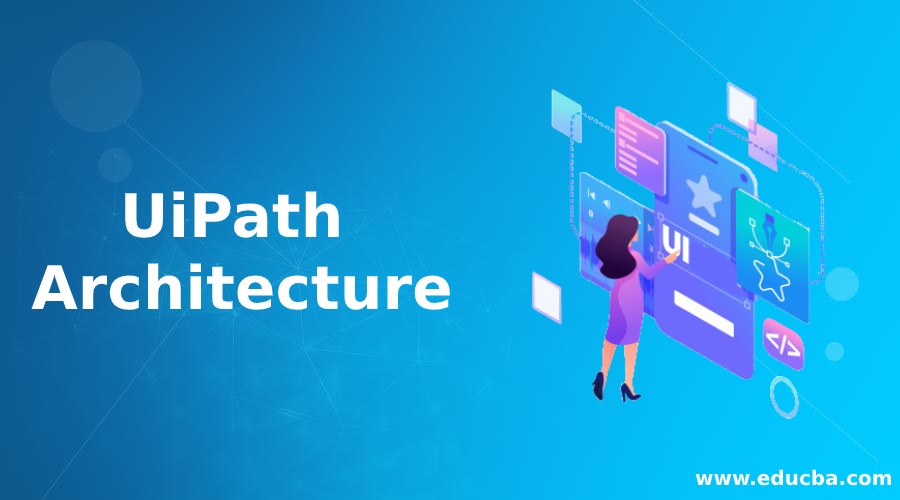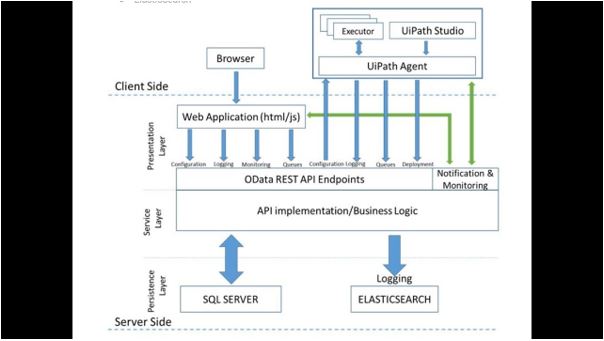Updated April 8, 2023
Introduction to UiPath Architecture
The UiPath Architecture includes the three UiPath components – Studio, Orchestrator, and Robot, along with the database servers and browser components. UiPath Studio is the GUI dashboard that helps in building the automation workflow. The Robot executes the automated steps or activities as described. The UiPath Orchestrator acts as the interface between Studio and Robot and manages the automation tasks. The UiPath architecture is mainly divided into three layers as the Client layer, the Server layer, and the Persistency layer. Let’s discuss in detail these three layers.
Architecture in Detail
Here is the details of UiPath Architecture:
UiPath Architecture is an enterprise RPA platform for process automation. The UiPath Architecture is set up by combining its components and database servers along with the communication channels. The above picture gives a fair idea of UiPath Architecture. The architecture can be explained in two ways, one is the client and server side detailing and second is the three layered detailing.
Classification of the UiPath Architecture
Let’s first talk about the easier classification of the UiPath Architecture:
The Client side and the Server side. The client-side includes those parts of UiPath Architecture, which can be directly accessed by the user or developer. So the client-side mainly includes UiPath Studio, UiPath Robot, Browser, and UiPath agent. Backend operations of UiPath Architecture are handled by the server-side. All activities and workflows, created by the user, are saved in the database. UiPath orchestrator picks the functions from the database and guides the Robot to work as per the code. Also, the logs are saved in the backend.
UiPath logs are extremely important in analysing the efficiency as well as identifying any error reasons. It is advised to equip SQL server for process details and elastic search for the log details. The wider narration of UiPath Architecture is explained by classifying the components into three layers – the client/presentation layer, the Server layer and the persistency layer. The client layer or the presentation layer includes the UiPath components which are directly accessed by the user, like the Studio, Robot, UiPath agent, the executors, and also, the browser which might be automated. This is where the user or developer is developing the code and the same are executed by robots.
- UiPath Studio is the designer tool that enables the coding in UiPath Architecture. Workflows for every action to be performed are created in the Studio, with several pre-built activities. Such activities are of drag and drop feature. It also helps to record any actions performed by both mouse click and keyboard strokes. Studio is enabled with logging and error handling features as well. It has many complexity levels like process, libraries, transactional process, agent process improvement and robotic enterprise framework. The studio is also integrated with OCR technologies to aid all text and image related functionalities.
- The robot is the automation worker. It executes the automation processes which are scripted in the studio. The projects designed by studio include step wise instructions for the robot to follow and this robot is managed by orchestrator. We can have a single Robot or multiple robots for same process, based on the complexity of our process.
The UiPath robot has the below two components:
- UiPath agent service is the intermediate between the client-side and the server-side of UiPath. All information will be communicated via the agent. Through the agent service, all messages are logged into the orchestrator and further processed to the SQL server.
- UiPath executor service is used by Robot to execute the tasks.
The latest AI enhancements allow robots to recognise objects on the screen and adjust to any screen changes. With this the Citrix environment automation is made 3 to 4 times faster than any other solutions.
The second layer is the Server layer. All Server details are provided in this layer. This layer mainly consists of the UiPath Orchestrator. The Orchestrator manages the entire automation work. It is the web-based management platform that helps to meet service levels and timelines. With minimal human interference, it monitors all activities, schedules robots and generates reports according to the requirements. It helps to orchestrate the UiPath Architecture robots in continuously executing repetitive process.
The third layer of the UiPath orchestrator is the persistency layer. This layer includes the database servers. The robot configuration details are stored in this layer. Configuration details describe which robot is specific to which user, details of the assigned processes like the environment used by a specific robot, the queues, queue items, the asset details, etc. These details will be defined by user in the orchestrator. Also, the logging information is stored here.
The log details updated by the UiPath agent services are saved in the persistency layer. From these logs, which are saved in elastic search, it is easy to identify the error messages and rectify them. The relational database management system (RDBMS) like SQL server can be is used for storing process level details whereas elastic search can be used for log information. This is because of the ease in retrieving search results related to logs which will be a larger quantity of data.
The UiPAth platform facilitates end to end process handling. It assures a fully automated workforce that gain capacity, enhance efficiency and increase process scalability and flexibility. UiPath is also advancing every day. One of the major changes in the UiPath studio is that since 2019 version, instead of SVN connections, it has access to Git.
Conclusion
So the three layers of UiPath Architecture are the Client layer, the Server layer, and the Persistency layer. The client layer comprises the UiPath studio, the UiPath robot, and it is in the client layer that the automation workflows are created and executed. The Server layer has orchestrator that orchestrates the robot execution which includes monitoring, deployment, configurations and queue management logging. And the third layer is the persistency layer, which has the database describing the assigned process, log information and environment details for every process and robot in action.
Recommended Articles
This is a guide to UiPath Architecture. Here we discuss the introduction to UiPath Architecture, along with the classification, and the block diagram of UiPath in detail. You can also go through our other related articles to learn more –




